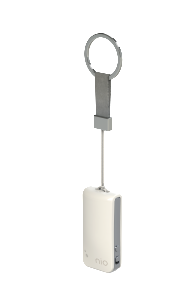The concept of a tracking tag was the stuff of spy novels, comic books and vaporware startups… but not anymore. At CE Week in New York City, there were three different smart tags, each enabling the owner to find the tag or be alerted when it move out of range of the paired device.

Each of the smart tag systems below pair with a dedicated smartphone application that tracks the devices and provides additional finding capabilities, all based on the strength of the bluetooth signal relative to the smartphone. All three systems can use the strength of the signal to set a virtual fence, activating an alarm when a tag is separated from the paired device.
The iFi smart tag is quite large (about the size of a car alarm keyfob), making ideal only if you’re trying to keep track of your keys. Obviously, an iFi smart tag could be placed in bags, briefcases, etc, but for smaller items it need to be attached somehow. Alternatively, if the iFi Smart Tag and device are separated by more than 30 feet, a security alarm will sound to alert you of potential loss or theft; the app also sends a Google map notification of the tag’s last GPS location and time of separation.
Oddly, there are separate models for iOS and Android with different prices. The iOS version of the iFi smart tag uses a coin cell battery and is expected to last about 4 months, the Android version uses a rechargeable battery, but will needs to be recharged every 3–4 days.
Amazon: iFi Smart Tag for iOS
Amazon: iFi Smart Tag for Android
The smart tag offering called nio is similar in function to the iFi smart tag but it’s design is less chunky, but is still large enough that it needs to be either attached by a leash of some kind or put within a package, bag, briefcase or something similar. The software is also more developed, allowing the alert distance to be set by the user. The nio tag also has the ability to trigger an alarm from both the smartphone and the tag; a user-selected tone and/or vibration. A single version serves both iOS and Android and is powered by a rechargeable battery that claims to only require charging every 2-4 months.

The Stick-N-Find smart tag seems to be a quantum leap above and beyond it’s peers at the CE Week Line Shows. Claiming a life of more than a year before replacement, the stick-n-find smart tag uses a common watch battery in it’s diminutive form. Each tag is about the size of a quarter and only 0.16″ thick, making them small enough to attach to objects that the first two smart tag options could not. Also OS-independent like the nio, the little disks come with an adhesive back to be attached nearly anywhere. Despite the small size, Stick-N-Find tags have both a buzzer and light, so that you can find stuff in the dark when the alert is triggered.
Amazon: Stick-N-Find Smart Tag (Set of 2)
Conclusion: While there is a clear “winner” at the CE Week Line Shows, the technology within a smart tag continues to improve. Tags will only get smaller and battery technology will only get better. Now that smart tags are (finally) commercially available, competition will take care of evolution and we will reap the benefits.
